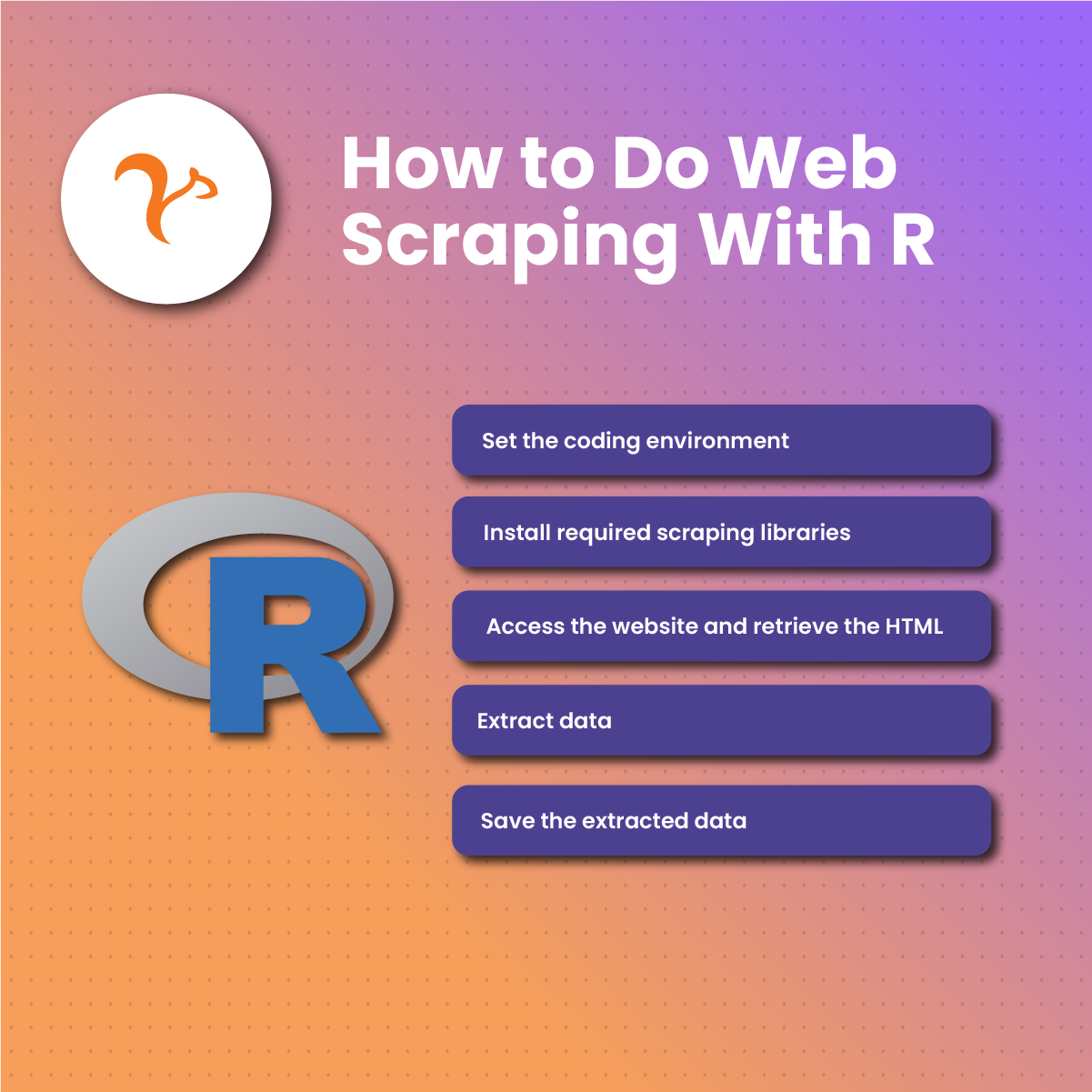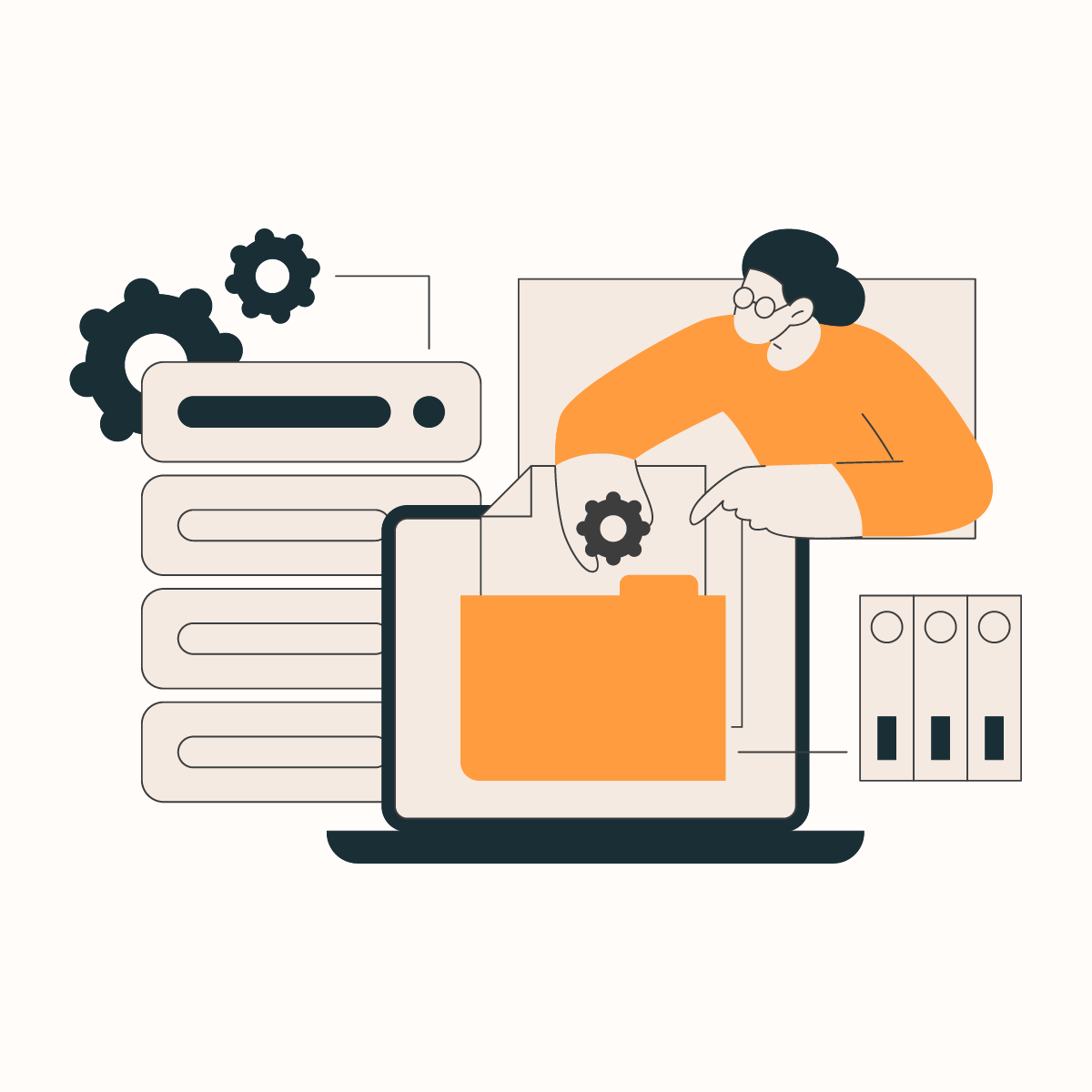Introduction
Web scraping is becoming increasingly important as businesses rely on updated or real-time data to make informed decisions. The concept of web scraping involves using tools to access target websites and download data in a format that is easy to use and understand. Businesses and researchers can leverage various tools to get data from target websites.
Web scraping with R is one method you can leverage to get the necessary data. This method automates the web data extraction process, which could have been otherwise repetitive and time-consuming.
This guide will examine the critical aspects of web scraping with R including its features, how to scrape a website, common challenges, pro tips and how to optimize them with NetNut proxies.
What is R?
R is a programming language designed for data analysis. Since there are numerous programming languages, picking the best one for your web scraping may be challenging. You can find a recent guide that comprehensively explains the best programming languages for web scraping.
According to the official website, “R is an integrated suite of software facilities for data manipulation, calculation, and graphical display.” In other words, R is a programming language designed to be a self-contained and flexible system for easy data management. Since R supports data analysis, it has features that help you get the best from the data you extract from target websites.
Web scraping with R is possible by writing R commands. Using the R package, Rvest, allows you to accomplish the task of scraping with only a few lines. This is similar to how libraries like BeautifulSoup play significant roles in Python web scraping. R has several features that make it an excellent alternative for web data collection and management. They include:
R is an open-source language
Web scraping with R is a friendly alternative because the language is open-source. In simpler terms, it is free to use by anyone who wants to program anything, especially a web scraper. In addition, since it is an open-source language, programmers can modify the code as required. Although you may not need to do significant modifications for web scraping with R, the feature is still helpful.
R is platform-independent
The developers of R designed it to be platform-independent. As a result, you can use this programming language on any platform, including Windows, Mac, and Linux.
Active community
R has an active community that ensures the functionality of the language is constantly optimized. Subsequently, the community is dedicated to developing new packages and libraries that increase the efficiency of R-based codes. In addition, you can always reach out to an expert if you run into any trouble for web scraping with R.
Compatibility with other languages
You can use R with any other programming language. This is possible because R is an open-source language. Therefore, various experts have incorporated their ideas into it and designed packages that connect it to other programming languages. As a result, even the most popular programming languages like Python, Java, and C++ can be used with R, as long as the right packages are integrated.
Introduction to Web Scraping with R
Web scraping is the process of collecting data from the web. The data is often stored in a local file where it can be accessed for analysis and interpretation. A simple example of web scraping is copying content from the web and pasting it into Excel.
Regardless of the language you use for web scraping, the process can be similar. The fundamental process of web scraping involves a programmed bot interacting with a website’s HTML code and finding specific information it saves on your device in a predetermined format.
However, before you proceed with web scraping with R, let us examine some fundamental steps. They include:
Determine the information you need to extract
The first factor to consider before diving into web scraping with R is determining the information you want to collect. The internet is a goldmine of information on various things, including finances, literary works, movie information, e-commerce information, and more. Therefore, you need to be specific about your target data to optimize web scraping with R. An e-commerce website, for example, contains various data, including product names, prices, reviews, images, product descriptions, and more.
Subsequently, when you do not specify the target data, the scraper may download all the data on the website. As a result, you are left with a large volume of data that is largely irrelevant to your activities. Consequently, you need to spend more time and resources sorting and analyzing the data.
Familiarize yourself with the structure of the target website
The next step is to understand the structure of the target website. At this stage, you must understand that each website has different structures. Programmers build site elements with various names, so the web page URL may be sequential digits or unique strings.
Therefore, it becomes critical to identify patterns on the target website that give you an advantage when writing the code for your web scraping with R. An easy method is to visit the web page in your browser and go through the HTML elements using the built-in developer tools.
Consider using an API
Many websites are wary of scrapers because they want to avoid aggressive scraping. Aggressive web scraping with R can cause a website to become slow and sometimes crash, depending on the intensity.
However, some websites, especially social media platforms, offer an API- Application Programming Interface that allows you to extract all the data you need without affecting the performance of the target website. Therefore, if a website offers an API, it is more ethical than deploying a web scraper. You can also use third party API like Google SERP scraper API and Social Scraper
How to Do Web Scraping With R
Set the coding environment
Before diving into web scraping with R, you need to download the latest version of R. At this time, you can download the R.4.3.2 since it is the latest version available. Another tool you need is an IDE- RStudio is an integrated development environment (IDE) for R and Python. Alternatively, you can use PyCharm or Visual Studio Code IDE. However, be sure to read through their official documentation to get a general overview of how they work.
Remember that you need to download and install R before you install the RStudio.
Install required scraping libraries
Suppose you choose to do web scraping with R. In that case, you have access to several helpful libraries, consisting of pre-written codes that you can leverage for certain tasks. One of the benefits of using a library is you don’t have to start writing the code from scratch. Instead, you can modify the codes to achieve your goal.
For web scraping with R, Rvest is the primary library that can optimize your scraping code. In addition, you can use it to build a web scraper since it is an all-in-one scraping library. Rvest is an R library that helps you scrape data from web pages through its advanced R web scraping API. This is necessary to successfully download an HTML document, parse it, and collect data.
You can install Rvest by opening the R Console in PyCharm with the command: install.packages(“rvest”)
Subsequently, you must wait for the installation to be complete- this may take a few seconds. The installation process is complete as long as the PyCharm does not present an error report.
Another library that may prove useful for web scraping with R is the tidyverse library. It contains codes that you can leverage to keep your data neat and organized. For large-scale scraping, you may need to scrape multiple pages simultaneously. Therefore, you need to install the polite library; this library ensures you don’t overload the website because this can lead to an IP ban.
Access the website and retrieve the HTML
You can use any browser to retrieve the website’s HTML for web scraping with R. Once you have installed all the necessary packages and have a strong internet connection, the program will automatically find the HTML via the URL you provided.
To access a website, the URL must be set as one of the variables. You can download the HTML document via the remote URL with Rvest with this code:
document <- read_html(“https://www.example.com“).
In addition, the read_html () function retrieves the HTML component through the URL that passes as a parameter. It then parses and assigns the extracted data structure to the document variable.
In addition, the polite library visits the website and goes through the robot.txt file to understand how web scraping with R should progress. This library also ensures you are not sending too many requests within seconds to avoid IP bans.
Before you can successfully perform web scraping with R, you need to identify and select the HTML elements. This is quite straightforward: right-click on a product HTML element and select inspect from the options. Subsequently, this will launch the DevTools pop-up mini-window.
Extract data
Once you have identified and selected the HTML elements, you are ready to extract the data in whatever format you prefer. First, go to the installed RStudio and create a new project. You can either create a new folder, use an existing folder, or use version control to manage it.
In addition, the polite library has a command called “scrape” that automates web scraping with R for you. The command looks like this: info < – scrape(url). Once you have identified and selected the HTML elements for the data you want to collect, web scraping with R becomes easy.
Save the extracted data
Finally, store the data on your computer’s local storage. The most common format is a CSV or XLS file, which is easy for humans to read and understand. Alternatively, you can store it in a JSON format or from the website in Excel.
Advanced Web Scraping with R
Parallel web scraping with R
Parallel web scraping with R may become necessary when the target website has many pages, or the server is responding slowly, which can prolong web data extraction. Since R supports parallelization, you can easily deal with this challenge. More so, parallel scraping usually involves extracting data from multiple web pages at the same time. Subsequently, it involves downloading, parsing, and retrieving data from multiple pages simultaneously, which optimizes the speed of web scraping.
For parallel web scraping with R, you need to import the parallel package on your terminal via: library(parallel)
Once the library is installed, you can use the utility functions for parallel computation. The script defines a scrape_page ( ) as a function to scrape a single web page. It then initializes an R cluster with makeCluster() which creates a set of copies of R instances that run in parallel and communicate via sockets. Therefore, each parallel instance will only have access to the defined parameters within the scrape_page()library(parallel).
Subsequently, if you implement this parallelization in web scraping with R, the performance will be optimized. However, this method of parallel web scraping with R is memory and resource-intensive. Therefore, be sure to consider these requirements before implanting the parallelization logic.
Dynamic web scraping with R
Scraping a website that contains dynamic content requires some more effort than a static website. For a static content website, you do not have to render the documents in a web browser before you can extract them. However, web pages are more than their HTML source codes. Therefore, when you render them in a browser, the web page can perform HTTP requests via AJAX and run JavaScript, which is necessary to dynamically retrieve data and modify the DOM as required.
For a website that contains dynamic content, the HTML source code usually does not contain the valuable parameters required to extract data. However, you can perform web scraping with R by rendering the target web page in a headless browser. We shall cover this concept in the next aspect of this guide.
Web scraping with R in headless mode
A headless browser allows you to load a web page in a browser that lacks a graphic user interface (GUI). Building an R web scraper with a headless browser allows you to interact with a website through JavaScript. Therefore, you can teach the browser to perform operations and mimic human users’ interactions.
One of the most popular headless browser libraries for web scraping with R is RSelenium. You can install it from the terminal via: install.packages(“RSelenium”). After installing it, run the code to extract the data from the target website. Moreover, RSelenium runs the web scraping process in a browser (headless browser), which gives you access to all the features available on the browser.
Using RSelenium involves understanding some methods that can be used to select various elements. The findElements() method can be used to select HTML elements. You can use the findChildElements() to choose a child element from the HTML element. In addition, getElementAttribute() and getElementText() to retrieve data from the selected HTML elements.
Selenium is a framework that automates various browser actions like scrolling, clicking, and typing that help a bot seem more human-like. RSelenium is a package that allows you to control a web browser from R via the Selenium WebDriver API. Therefore, RSelenium is a package that allows you to extract data from dynamic websites. These websites are dynamic because they use AJAX, JavaScript, and other technologies that can change the content of the page after it has loaded. In addition, RSelenium can take screenshots and manage pop-ups, alerts, and multiple windows.
Furthermore, using RSelenium for web scraping with R minimizes the chances of being blocked. This is because the activities involved in scraping are conditioned to imitate that of a regular user. Therefore, this makes RSelenium for web scraping with R a popular alternative among experts.
Common Challenges Associated with Web Scraping With R
Web scraping with R is an excellent choice but is not completely free from challenges. This may cause some stress, especially when you frequently need large volumes of data. Therefore, it is important to understand these challenges and how they affect data extraction activities. Here are some of the challenges you may encounter during web scraping with R:
Authentication
One of the challenges to performing web scraping with R is authentication. This challenge arises because many websites require you to log in before you can access the website content. Once you have identified this requirement, you can use the rvest html_form() command to log in before you attempt to extract the data.
When you need to scrape multiple pages, you can use this command- html_form_submit() to submit the forms you need and move on to the next page. Doing this before you initiate web scraping with R ensures you don’t have to log in when you need to access each page.
Unstructured HTML
Another challenge to web scraping with R is unstructured HTML. Websites may have unstructured HTML when they use server-side CSS classes and attributes. Alternatively, the website may have been poorly programmed, which poses a significant challenge for web scraping with R. Therefore, if you encounter a website that does not follow a pattern, you need to extract data one page at a time.
CAPTCHA
CAPTCHA is one of the most popular challenges associated with web scraping with R. Completely Automated Public Turing Tests To Tell Computers and Humans, often called CAPTCHA, is a common security measure by websites to restrict web scraping activities. CAPTCHA requires manual interaction to solve a puzzle before accessing specific content. It could be in the form of text puzzles, image recognition, or analysis of user behavior.
A solution to this problem could be to implement CAPTCHA solvers when writing the code for web scraping with R. However, this may potentially slow down the process of web data extraction. Subsequently, using NetNut proxies is a secure and reliable way to bypass CAPTCHAs.
IP block
Web scraping with R involves sending a request to the target website. Subsequently, the website can identify your IP address, which can be used to determine your location and other identifying factors.
Therefore, you can experience IP blocks during web scraping with R due to geographical restrictions. Also, your IP address can be banned when you send too many requests within a short period. As a result, you cannot access the content on your target website.
IP blocks can be resolved by using a reliable proxy server like NetNut during web scraping with R. Although there are various available free proxies, they can be quite unreliable. Using an unreliable proxy IP can trigger the website to ban or block your IP address.
Honeypots
Honeypots are traps employed by some websites to identify and block web scrapers. They are in the form of links that are hidden behind invisible CSS elements on a website. Bots usually will click on every link on the target page, which will trigger the anti-scraping measure to block your scraper. However, you can instruct the bot to ignore whatever is behind an invisible CSS element for web scraping with R.
Dynamic Content
A website with dynamic content can pose a challenge for web scraping with R. Web scraping primarily involves analyzing the HTML source code. However, modern websites are often dynamic, which poses a challenge to web scraping. For example, some websites use client-side rendering technologies such as JavaScript to create dynamic content.
Therefore, many modern websites are built with JavaScript and AJAX after loading the initial HTML. Subsequently, you would need a headless browser to request, extract, and parse the required data. Alternatively, you can use tools like Selenium, Puppeteer, and Playwright to optimize the web data extraction process.
Pro Tips for Web Scraping with R
Web scraping with R is an exciting journey, but there are certain things you can do to optimize it. Here are some pro tips that can help you take web scraping with R to a new level:
Scrape multiple URLs simultaneously
Many websites have multiple pages, so if you are writing code for web scraping with R, it has to cater to all the pages. Therefore, implementing loops in your code is the easiest way to do this.
For example, you can add the purr library or use the lapply() command with the code for web scraping with R. Subsequently, these functions allow you to repeat the process of scraping across various URLs.
Alternatively, you can use the tibbles library to create data frames and collect data from multiple web pages. Subsequently, this allows you to create a loop where the program automatically switches to a new URL after successfully completing each web scraping. The process is repeated until you have scraped all the required URLs.
Prepare for forms
You may encounter forms when performing web scraping with R, so you must be prepared. Using rvest allows you to work with these forms easily, provided they are built with HTML. Subsequently, you can use rvest’s html_form() function to scrape forms and dropdown menus from various websites. Apart from this function, rvest offers functions that allows you to set a form field as well as submit a required form.
Leverage other programming languages
One unique feature of R is that you can connect it with other programming languages. There are several free packages that allow you to connect R with Python, Java, C++, and others. In addition, RStudio has a native integration to connect any other programming language you prefer.
The ability to connect with other programming languages is crucial for web scraping with R, especially if the target website depends on JavaScript. For example, connecting to the PhantomJS program allows you to load content into your R scraper.
Avoid a robotic scraping pattern
Another pro tip to optimize web scraping with R is to avoid robotic scraping patterns. This is because many websites have measures to identify and block malicious bots. However, since your web scraper is also a bot, it may be affected by these measures.
These anti-bot measures work by looking out for robotic behaviors among users. Some behaviors that can trigger the system include sending too many requests in a short time. Therefore, if you are performing web scraping with R, you should slow down your program so your activity seems like that of a regular human user. If you have already used the polite library, you are on the right path because it examines the robot.txt file and slows down your web scraper to a moderate speed.
Use a proxy server
Web scraping with R is incomplete without using a proxy server. Proxies act as intermediaries between your device and the target website. Subsequently, they hide your IP address and digital footprints for optimized anonymity and security. When you use a proxy server for web scraping with R, you don’t have to worry about an IP ban because you have access to a pool of IP addresses. In addition, using proxies for web scraping with R makes your activities seem more human and less robotic.
The Best Proxy Solution for Web Scraping with R: NetNut Proxies
As mentioned earlier, one tip for optimizing web scraping with R is using proxies. While several free proxies are available, you don’t want to sacrifice cost for functionality. Therefore, choosing an industry-leading proxy server provider like NetNut becomes critical.
NetNut has an extensive network of over 52 million rotating residential proxies in 200 countries and over 250,000 mobile IPS in over 100 countries, which helps them provide critical resources for data collection.
NetNut offers various proxy solutions designed to overcome the challenges of web scraping with R. In addition, the proxies promote privacy and security while extracting data from the web.
NetNut rotating residential proxies are your automated proxy solution that ensures you can access websites despite geographic restrictions. Therefore, you get access to real-time data from all over the world that optimizes decision-making.
Alternatively, you can use our in-house solution- NetNut Scraper API, to access websites and collect data. Moreover, if you need customized web scraping solutions, you can use NetNut’s Mobile Proxy.
Conclusion
This guide has examined how to perform web scraping with R. Although there are other popular programming languages, R was designed for statistics and is widely used by data analysts.
We also went through a detailed process of web scraping with R- from installing R, libraries, setting the environment, handling dynamic content, and extracting the data. Although R is an excellent language for web scraping, you may encounter some challenges like honeypots, IP bans, authentication, unstructured HTML, and more.
However, if you follow the pro tips we have recommended in this guide, web scraping with R will be optimized. In addition, NetNut proxies offer a unique, customizable, and flexible solution to these challenges.
Kindly contact us if you have any further questions! Remember, NetNut proxies are your best partners for efficient web scraping with R.
Frequently Asked Questions
What is Rvest?
Rvest is one of the most popular web scraping R libraries. It offers several functions that make web scraping with R much easier. In addition, it allows you to download HTML documents and collect data from them. Rvest is a package that is based on the html5lib and xml2 packages. Therefore, it makes web scraping with R fast and convenient by providing a consistent method to parse HTML and XML documents.
In addition, Rvest provides the feature that allows you to select and extract data from websites via XPath expressions and CSS locators. Subsequently, these two methods allow you to easily locate elements in a web page during web scraping with R. Moreso, Rvest has functionalities to fill forms, handle cookies, and navigate links.
Can I use Rvest and RSelenium together?
Yes, you can use Rvest and RSelenium together. The need to combine these two powerful libraries may arise when the website contains both dynamic and static content. Therefore, you may need to leverage RSelenium to access specific dynamic pages that require human interaction, such as filling out a form or clicking a button. On the other hand, Rvest plays a crucial role in extracting the data from the HTML source via the XPath expressions and CSS selectors.
What are the advantages and cons of using R?
R is a programming language developed in 1993 by Ross Ihaka and Robert Gentleman as an environment for statistical computing. Here are some of the pros and cons of using R:
Advantages of R
- It is an open-source language
- R is user-friendly
- You can easily pair it with any other programming language
- Dedicated to data analysis
- Prebuilt templates for web scraping with R
- Programs are quick
- Provides excellent support for large datasets
- R is platform-independent
- It is packed with over 10,000 packages
- This programming language is great for statistics and Machine Learning
Disadvantages of R
- Low security
- Slower than python
- Not the easiest language to learn
- R is memory-intensive









